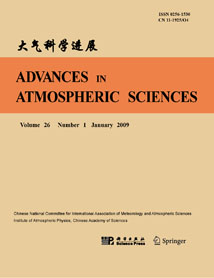| [1] |
Ghulam RASUL, Qamar-uz-Zaman CHAUDHRY, ZHAO Sixiong, ZENG Qingcun, QI Linlin, ZHANG Gaoying,
2005: A Diagnostic Study of Heavy Rainfall in Karachi Due to Merging of a Mesoscale Low and a Diffused Tropical Depression during South Asian Summer Monsoon, ADVANCES IN ATMOSPHERIC SCIENCES, 22, 375-391.
doi: 10.1007/BF02918751
|
| [2] |
Daeun JEONG, Ki-Hong MIN, Gyuwon LEE, and Kyung-Eak KIM,
2014: A Case Study of Mesoscale Convective Band (MCB) Development and Evolution along a Quasi-stationary Front, ADVANCES IN ATMOSPHERIC SCIENCES, 31, 901-915.
doi: 10.1007/s00376-013-3089-9
|
| [3] |
Xiuping YAO, Qin ZHANG, Xiao ZHANG,
2020: Potential Vorticity Diagnostic Analysis on the Impact of the Easterlies Vortex on the Short-term Movement of the Subtropical Anticyclone over the Western Pacific in the Mei-yu Period, ADVANCES IN ATMOSPHERIC SCIENCES, 37, 1019-1031.
doi: 10.1007/s00376-020-9271-y
|
| [4] |
Xu Liren, Zhao Ming,
2000: The Influences of Boundary Layer Parameterization Schemes on Mesoscale Heavy Rain System, ADVANCES IN ATMOSPHERIC SCIENCES, 17, 458-472.
doi: 10.1007/s00376-000-0036-3
|
| [5] |
Shou Shaowen, Liu Yaohui,
1999: Study on Moist Potential Vorticity and Symmetric Instability during a Heavy Rain Event Occurred in the Jiang-Huai Valleys, ADVANCES IN ATMOSPHERIC SCIENCES, 16, 314-321.
doi: 10.1007/BF02973091
|
| [6] |
Huiyan XU, Xiaofan LI, Jinfang YIN, Dengrong ZHANG,
2023: Predecessor Rain Events in the Yangtze River Delta Region Associated with South China Sea and Northwest Pacific Ocean (SCS-WNPO) Tropical Cyclones, ADVANCES IN ATMOSPHERIC SCIENCES, 40, 1021-1042.
doi: 10.1007/s00376-022-2069-3
|
| [7] |
Zhao Qiang, Liu Shikuo,
1999: Simplification of Potential Vorcticity and Mesoscale Quasi-balanced Dynamics Model, ADVANCES IN ATMOSPHERIC SCIENCES, 16, 304-313.
doi: 10.1007/BF02973090
|
| [8] |
JIANG Yongqiang, WANG Yuan, HUANG Hong,
2012: A Study on the Dynamic Mechanism of the Formation of Mesoscale Vortex in Col Field, ADVANCES IN ATMOSPHERIC SCIENCES, 29, 1215-1226.
doi: 10.1007/s00376-012-1186-9
|
| [9] |
Yongqiang JIANG, Yuan WANG, Chaohui CHEN, Hongrang HE, Hong HUANG,
2019: A Numerical Study of Mesoscale Vortex Formation in the Midlatitudes: The Role of Moist Processes, ADVANCES IN ATMOSPHERIC SCIENCES, 36, 65-78.
doi: 10.1007/s00376-018-7234-3
|
| [10] |
Guanshun ZHANG, Jiangyu MAO, Wei HUA, Xiaofei WU, Ruizao SUN, Ziyu YAN, Yimin LIU, Guoxiong WU,
2023: Synergistic Effect of the Planetary-scale Disturbance, Typhoon and Meso-β-scale Convective Vortex on the Extremely Intense Rainstorm on 20 July 2021 in Zhengzhou, ADVANCES IN ATMOSPHERIC SCIENCES, 40, 428-446.
doi: 10.1007/s00376-022-2189-9
|
| [11] |
PAN Yang, YU Rucong, LI Jian, XU Youping,
2008: A Case Study on the Role of Water Vapor from Southwest China in Downstream Heavy Rainfall, ADVANCES IN ATMOSPHERIC SCIENCES, 25, 563-576.
doi: 10.1007/s00376-008-0563-x
|
| [12] |
Keon Tae SOHN, Jeong Hyeong LEE, Soon Hwan LEE, Chan Su RYU,
2005: Statistical Prediction of Heavy Rain in South Korea, ADVANCES IN ATMOSPHERIC SCIENCES, 22, 703-710.
doi: 10.1007/BF02918713
|
| [13] |
SUN Li, SHEN Baizhu, SUI Bo,
2010: A Study on Water Vapor Transport and Budget of Heavy Rain in Northeast China, ADVANCES IN ATMOSPHERIC SCIENCES, 27, 1399-1414.
doi: 10.1007/s00376-010-9087-2
|
| [14] |
XIONG Zhe, WANG Shuyu, ZENG Zhaomei, FU Congbin,
2003: Analysis of Simulated Heavy Rain over the Yangtze River Valley During 11-30 June 1998 Using RIEMS, ADVANCES IN ATMOSPHERIC SCIENCES, 20, 815-824.
doi: 10.1007/BF02915407
|
| [15] |
SHAO Aimei, QIU Chongjian, LIU Liping,
2004: Kinematic Structure of a Heavy Rain Event from Dual-Doppler Radar Observations, ADVANCES IN ATMOSPHERIC SCIENCES, 21, 609-616.
doi: 10.1007/BF02915728
|
| [16] |
Minwei Qian, N. Loglisci, C. Cassardo, A. Longhetto, C. Giraud,
2001: Energy and Water Balance at Soil-Air Interface in a Sahelian Region, ADVANCES IN ATMOSPHERIC SCIENCES, 18, 897-909.
|
| [17] |
WEI Na, LI Ying,
2013: A Modeling Study of Land Surface Process Impacts on Inland Behavior of Typhoon Rananim (2004), ADVANCES IN ATMOSPHERIC SCIENCES, 30, 367-381.
doi: 10.1007/s00376-012-1242-5
|
| [18] |
GAO Shouting, XU Pengcheng, LI Na,
2012: On the Generalized Ertel--Rossby Invariant, ADVANCES IN ATMOSPHERIC SCIENCES, 29, 690-694.
doi: 10.1007/s00376-012-1145-5
|
| [19] |
ZHOU Lian-Tong, Chi-Yung TAM, ZHOU Wen, Johnny C. L. CHAN,
2010: Influence of South China Sea SST and the ENSO on Winter Rainfall over South China, ADVANCES IN ATMOSPHERIC SCIENCES, 27, 832-844.
doi: 10.1007/s00376--009-9102-7
|
| [20] |
Baofeng JIAO, Lingkun RAN, Na LI, Ren CAI, Tao QU, Yushu ZHOU,
2023: Comparative Analysis of the Generalized Omega Equation and Generalized Vertical Motion Equation, ADVANCES IN ATMOSPHERIC SCIENCES, 40, 856-873.
doi: 10.1007/s00376-022-1435-5
|















 AAS Website
AAS Website 
 AAS WeChat
AAS WeChat 
 DownLoad:
DownLoad: